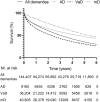Dementia epidemiology in Hungary based on data from neurological and psychiatric specialty services
- PMID: 33990624
- PMCID: PMC8121883
- DOI: 10.1038/s41598-021-89179-3
Dementia epidemiology in Hungary based on data from neurological and psychiatric specialty services
Abstract
Hungary has a single-payer health insurance system covering 10 million inhabitants. All medical reports of the in- and outpatient specialist services were collected in the NEUROHUN database. We used ICD-10 codes of Alzheimer's disease (AD), vascular dementia (VaD), miscellaneous dementia group and mild cognitive impairment (MCI) for the inclusion of the patients. Incidence, prevalence and survival of different dementias and MCI were calculated and analyzed depending on the diagnoses given by neurological or psychiatric services or both. Between 2011 and 2016, the mean crude incidence of all dementias was 242/100,000/year, whereas the age standardized incidence was 287/100,000/year. Crude and age standardized mean prevalence rates were 570/100,000 and 649/100,000, respectively. There were significantly more VaD diagnoses than AD, the VaD:AD ratio was 2.54:1, being the highest in patients with psychiatric diagnoses only (4.85:1) and the lowest in patients with only neurological diagnoses (1.32:1). The median survival after the first diagnosis was 3.01 years regarding all dementia cases. Compared to international estimates, the prevalence of dementia and MCI is considerably lower in Hungary and the VaD:AD ratio is reversed.
Conflict of interest statement
The authors declare no competing interests.
Figures




Similar articles
-
Is mild cognitive impairment prodromal for vascular dementia like Alzheimer's disease?Stroke. 2002 Aug;33(8):1981-5. doi: 10.1161/01.str.0000024432.34557.10. Stroke. 2002. PMID: 12154249
-
Metabolic Syndrome, Mild Cognitive Impairment, and Dementia: A Meta-Analysis of Longitudinal Studies.Am J Geriatr Psychiatry. 2019 Jun;27(6):625-637. doi: 10.1016/j.jagp.2019.01.214. Epub 2019 Feb 15. Am J Geriatr Psychiatry. 2019. PMID: 30917904
-
The epidemiology of mild cognitive impairment, Alzheimer's disease and related dementia in U.S. veterans.Alzheimers Dement. 2023 Sep;19(9):3977-3984. doi: 10.1002/alz.13071. Epub 2023 Apr 28. Alzheimers Dement. 2023. PMID: 37114952
-
[Survey of comorbidities for hospitalized patients with cognitive disorders].Zhonghua Yi Xue Za Zhi. 2012 Jan 17;92(3):156-9. Zhonghua Yi Xue Za Zhi. 2012. PMID: 22490735 Chinese.
-
Diagnosis and management of vascular cognitive impairment and dementia.J Neural Transm Suppl. 2002;(63):91-109. doi: 10.1007/978-3-7091-6137-1_6. J Neural Transm Suppl. 2002. PMID: 12597611 Review.
Cited by
-
Developing a Health Support System to Promote Care for the Elderly.Sensors (Basel). 2025 Jan 14;25(2):455. doi: 10.3390/s25020455. Sensors (Basel). 2025. PMID: 39860825 Free PMC article.
-
Cholinesterase inhibitors for the treatment of dementia: real-life data in Hungary.Geroscience. 2022 Feb;44(1):253-263. doi: 10.1007/s11357-021-00470-7. Epub 2021 Oct 15. Geroscience. 2022. PMID: 34655009 Free PMC article.
-
Suicide-Related Single Nucleotide Polymorphisms, rs4918918 and rs10903034: Association with Dementia in Older Adults.Genes (Basel). 2022 Nov 21;13(11):2174. doi: 10.3390/genes13112174. Genes (Basel). 2022. PMID: 36421848 Free PMC article.
-
Micro-gyms as a catalyst for healthy aging in university and healthcare settings: applications for the Semmelweis-EUniWell Workplace Health Promotion Model Program.Geroscience. 2025 Aug;47(4):5559-5575. doi: 10.1007/s11357-025-01595-9. Epub 2025 Mar 15. Geroscience. 2025. PMID: 40088392 Free PMC article. Review.
-
Exploration of the Hungarian Version of Test Your Memory in General Practice: A Cross-Sectional Correlational Study of a Convenience Sample of Middle-Aged and Older Adults.Geriatrics (Basel). 2024 Jun 3;9(3):74. doi: 10.3390/geriatrics9030074. Geriatrics (Basel). 2024. PMID: 38920430 Free PMC article.
References
-
- Prince, M., Wimo, A.G.M., Ali, G.C., Wu, Y.T. & Prina, M. World Alzheimer Report 2015: The global impact of dementia: an analysis of prevalence, incidence, cost and trends. (Alzheimer’s Disease International, London). https://www.alzint.org/resource/world-alzheimer-report-2015/. Accessed 4 Jan 2021
Publication types
MeSH terms
LinkOut - more resources
Full Text Sources
Other Literature Sources
Medical

